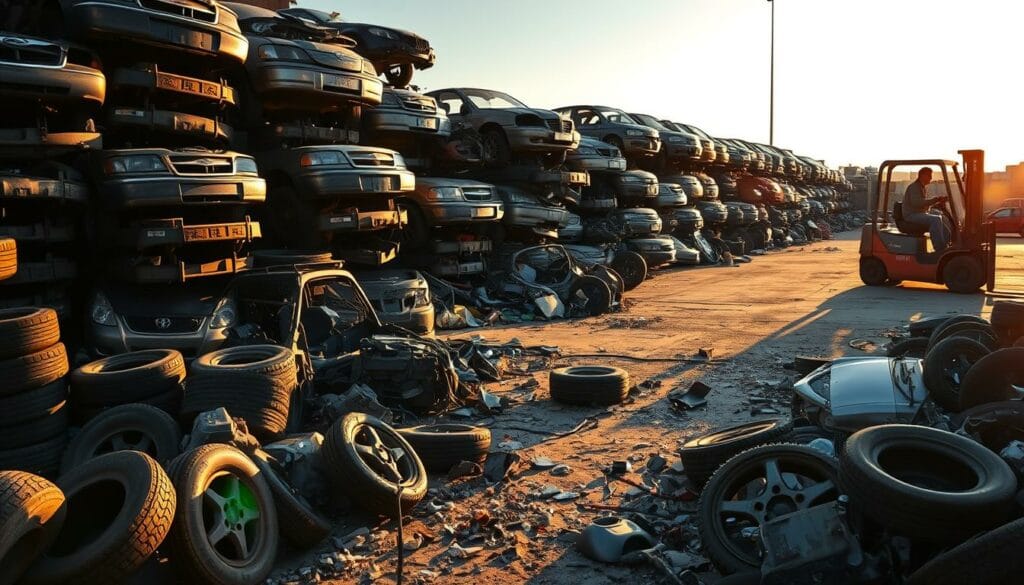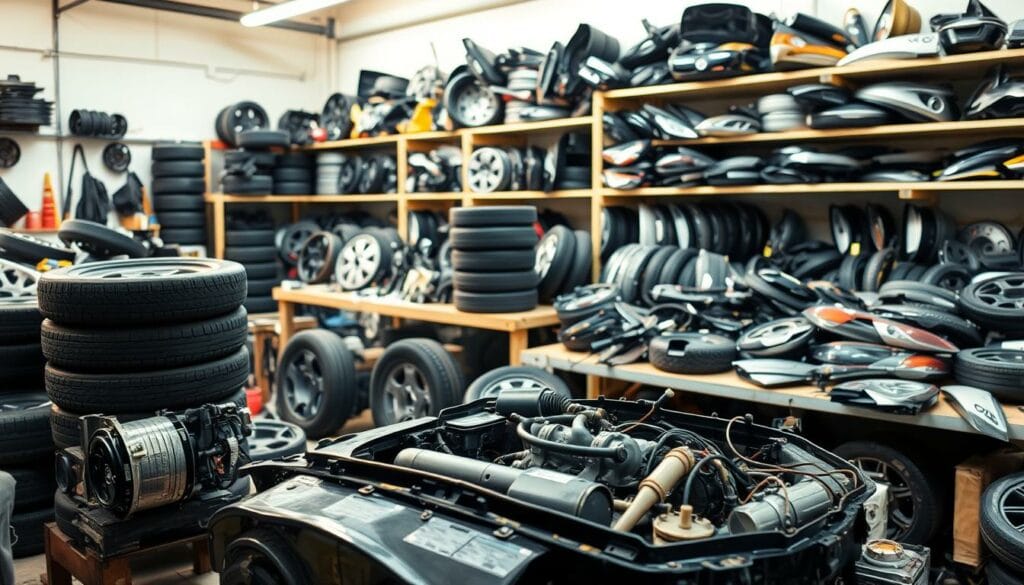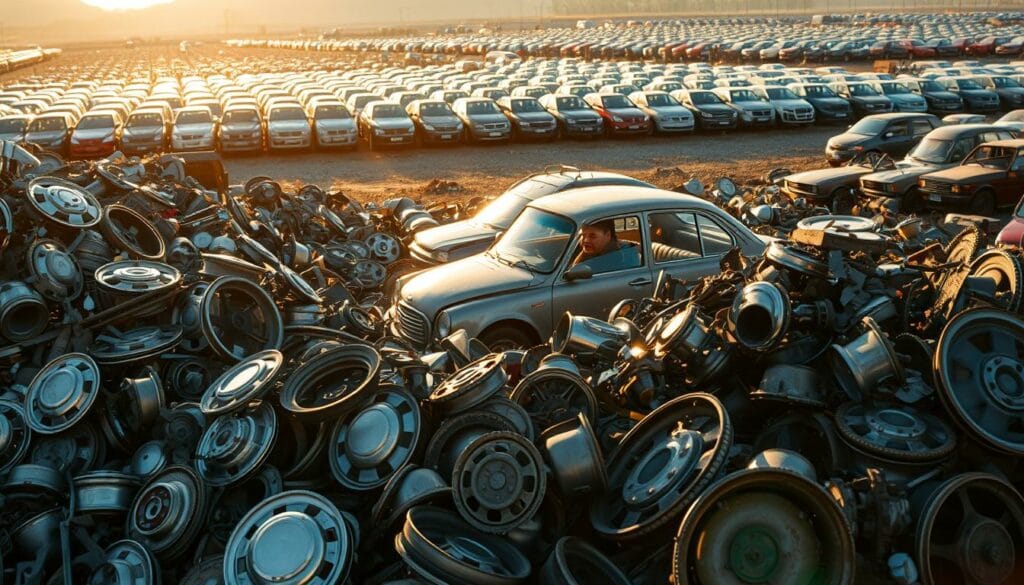
Did you know that over 80% of a vehicle’s weight can be reused or recycled? This means that every time you choose to recycle, you’re helping to save energy, raw materials, and reduce pollution. At Cash For Car, we believe in making this process easy and accessible for Canadians.
Improper handling of vehicle components can lead to environmental issues, such as toxic fluid leaks and unnecessary landfill use. By recycling, we can reclaim valuable material and prevent harm to our planet. For example, proper oil draining and controlled fluid disposal are essential steps in this process.
Our guide will walk you through the benefits of recycling, cost-saving opportunities, and safe procedures. Whether you’re looking for places to scrap cars near me or want to learn more about industry practices, we’ve got you covered. Let’s work together to make a positive impact on the environment.
Every year, millions of vehicles reach the end of their life cycle, but their parts don’t have to. Recycling these components is a simple yet powerful way to protect our environment and save money. By reusing materials, we reduce the need for new production and cut down on harmful waste.
Recycling car parts has a significant impact on the environment. It reduces landfill usage, which is crucial since vehicles take up considerable space when discarded improperly. Additionally, reusing materials like steel and aluminum saves energy—up to 74% for steel and the equivalent of 21 barrels of oil for aluminum.
Proper handling of hazardous items, such as oil and batteries, prevents toxic leaks into the soil. Recycling also lowers greenhouse gas emissions by reducing the need for mining and manufacturing new components. This makes it a key step in combating climate change.
Recycling isn’t just good for the planet—it’s good for your wallet too. Recycled parts often cost half the price of new ones, making them a budget-friendly option for repairs. Programs like Cash For Car also offer incentives for turning in old components, adding to your savings.
By supporting local recycling initiatives, we contribute to a circular economy. This means fewer resources are wasted, and more value is extracted from every item. Together, we can make a positive impact while keeping costs low.
Many car components can find new life through recycling, reducing waste and conserving resources. From engines to tires, numerous parts can be reused or repurposed. Understanding what can be recycled helps us make smarter choices for the environment.

Engines, batteries, and tires are among the most commonly recycled items. These parts contain valuable materials like steel, lead, and rubber that can be reused. For example, car batteries are processed to recover lead and plastic, while tires are shredded for use in products like rubberized asphalt.
Body panels and glass are also recyclable. Steel from doors and frames is melted down for new production, and automotive glass is repurposed into insulation or bottles. Recycling these parts reduces the need for raw materials and saves energy.
Some components, like mercury switches or parts with residual oil, pose challenges. These items require specialized handling to prevent environmental harm. Proper oil draining and fluid collection are essential steps in safe recycling.
Local scrap yards and recycling centres play a key role in managing complex waste. They use advanced methods to dismantle and process hazardous materials, ensuring they don’t end up in landfills.
| Part | Recycling Process | Benefits |
|---|---|---|
| Engines | Dismantled for metal recovery | Reduces mining needs |
| Batteries | Lead and plastic extraction | Prevents toxic leaks |
| Tires | Shredded into crumb rubber | Creates new products |
| Glass | Melted for insulation | Conserves resources |
By identifying which parts can be refurbished and which need proper disposal, we contribute to a cleaner, more sustainable future. Let’s work together to make recycling a priority.
Properly handling old car components can make a big difference for the environment and your wallet. Recycling these items ensures they don’t end up as harmful waste and helps conserve valuable resources. Let’s explore the steps to do it right.

Finding local centres for recycling is easier than you think. Start by checking directories or programs like Cash For Car, which connects you with certified facilities. Many centres accept a wide range of items, from engines to tires.
Safety is key when removing car components. Start by draining fluids like oil, as an average of 40 litres is removed per vehicle. Use proper tools and protective gear to avoid accidents.
Once you drop off your items, the recycling process begins. Facilities inspect and sort parts, separating ferrous and non-ferrous materials. Valuable resources like steel and rubber are recovered and reused.
This process minimizes waste and ensures harmful items don’t reach the landfill. By following these steps, you contribute to a cleaner, more sustainable future.
Recycling car parts doesn’t always mean sending them to a scrap yard. There are creative and eco-friendly ways to give these components a second life. By exploring alternatives like donation and upcycling, we can reduce waste and support a circular economy.
Donating functioning components is a great way to help others while keeping items out of landfills. Many community workshops and organizations accept used car parts for repairs or educational purposes. For example, donated engines or tires can be refurbished and reused, saving valuable resources.
Local initiatives often promote this practice, ensuring that every item finds a new purpose. By donating, we contribute to reducing waste and supporting those in need. It’s a win-win for the environment and our communities.
Upcycling turns old components into something new and useful. Car parts like tires, mirrors, and even seats can be transformed into unique DIY projects. For instance, old tires can become garden planters, and car mirrors can be repurposed as decorative wall art.
These creative ideas not only reduce waste but also add a personal touch to your home or workspace. Upcycling is a fun way to extend the life of materials while minimizing our environmental footprint.
“Every saved item contributes to a cleaner, more sustainable future.”
By choosing these alternative methods, we can make a positive impact. Whether it’s donating to local programs or crafting something new, every effort counts. Let’s work together to keep car components out of landfills and give them a second chance.
Finding the right way to handle old vehicle components can be easier than you think. With various methods available, it’s important to choose the one that best suits your needs while minimizing environmental impact. Let’s explore the options and guide you through the process.
There are several ways to manage used car materials effectively. Traditional methods include taking components to local scrap yards or recycling centres. These facilities often process items like engines, batteries, and tires, ensuring they’re reused or repurposed.
Modern alternatives, such as advanced parts locator networks, simplify the process. These digital tools help you find certified centres quickly and efficiently. They also ensure that your items are handled responsibly, reducing waste and conserving resources.
Locating nearby centres is straightforward. Start by searching online for “places to scrap cars near me.” Programs like Cash For Car connect you with certified facilities, making the collection process seamless.
Using digital tools offers significant advantages. Parts locator networks streamline the process, saving you time and effort. They also ensure that your items are processed responsibly, contributing to a cleaner environment.
These tools are particularly useful for managing complex materials, such as those with residual fluids. By leveraging technology, we can make recycling more accessible and effective for everyone.
| Option | Process | Benefits |
|---|---|---|
| Traditional Recycling | Drop off at local centres | Widely available, cost-effective |
| Parts Locator Networks | Digital search and drop-off | Efficient, eco-friendly |
| Cash For Car Programs | Certified facility connections | Convenient, reliable |
By evaluating your options and using the right tools, you can make a positive impact. Whether you choose traditional methods or modern alternatives, every effort counts. Let’s work together to reduce waste and promote sustainability.
Every recycled item from a vehicle contributes to a cleaner environment. By choosing to recycle, we conserve resources, reduce pollution, and save energy. Properly handling materials like oil ensures harmful substances don’t harm our planet.
Local programs make recycling easy and accessible. Many yards and centres accept a wide range of materials, from engines to tires. These initiatives not only reduce waste but also support our communities.
Let’s work together to make a difference. By recycling, we protect our environment and create a sustainable future. Start today by finding a nearby program and join the effort to reduce waste.
Recycling car parts helps reduce waste in landfills and lowers environmental harm. It also saves money by reusing materials instead of buying new ones.
Common parts like batteries, tires, and metal components can be recycled. Some harder-to-recycle items, like oil filters, require special handling.
Local scrap yards, recycling centres, and auto shops often accept car parts. Check with programs like Canadian Tire or municipal waste services for options.
Safely remove parts, clean them if needed, and separate materials. For example, drain oil from filters before recycling.
Recycled materials are processed and reused in new products. Metals might be melted down, while rubber can be repurposed for other uses.
Yes, many charities and repair shops accept donations. It’s a great way to give parts a second life while helping others.
Absolutely! Old parts can be upcycled into furniture, art, or DIY projects. It’s a fun way to reduce waste and get creative.
Look for local scrap yards or recycling programs that offer the best rates or services. Municipal websites often list approved locations.